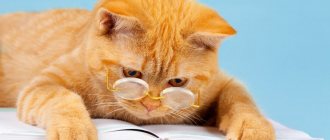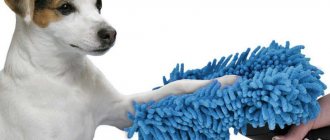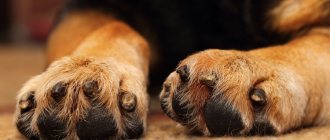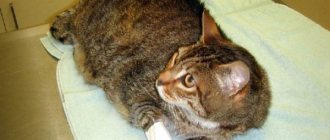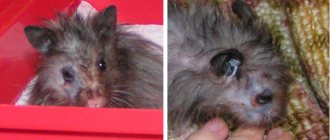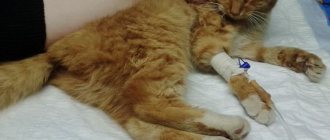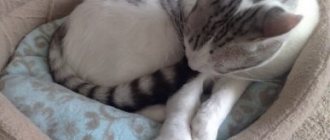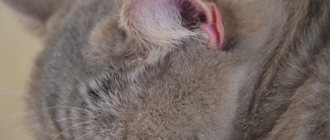The structure of a cat's paws
The light, dancing gait of cats cannot fail to attract attention. Take a closer look: they walk on their toes, like ballerinas! The cat does not step on its heel when walking, the paw remains collected and rounded, and the sharp claws are securely hidden in special “cases.”
The paw is designed in such a way that every finger and every claw is reliably protected. Between the toes, much coarser hair grows than throughout the animal’s entire body, and the base of the toes is protected by elastic, hairless pads.
Nature has reliably protected cat fingers and claws
Cat's paws are perfection conceived and realized by nature and deserve a separate story. All joints and joints are endowed with extraordinary mobility, which not only ensures graceful movements, but also allows, if necessary, to run very quickly, jump high and far, and perform unimaginable somersaults and pirouettes. The motor reactions of this animal are faster and more accurate than those of any mammal.
Flexible and tenacious fingers allow cats to move on any surface
Fingers are especially flexible - each of them seems to live a separate life, moving, bending and unbending independently of all the others. Thanks to this, cats instantly find balance and stay on almost vertical, uneven, slippery, very risky surfaces.
The cat puts its paw on its toes, the heel remains high above the ground
The famous cat toe-walking is complemented by another gait feature called ambling. All cats are pacers: they alternately move all their right paws, and then the two left ones. This allows predators to confuse their tracks, for secret purposes accurately placing one fingerprint on another. In addition, ambling makes the cat more stable and maneuverable - it makes it possible to quickly develop speed and change the direction of movement.
The pacer cats can walk, accurately following the trail.
Infrequently, but such a congenital pathology as shortened toes on the front or hind legs still occurs. An animal with such an anomaly cannot fully move; in the wild or on the street it will inevitably die. A domestic kitten with underdeveloped toes usually adapts to walking on its own, albeit slowly, with its paws tucked under it. Such individuals, of course, should not give birth to offspring - it is better to sterilize them in a timely manner.
The fingers and claws on the front paws of all cats are designed to catch and hold prey - they are much weaker than the striking hind limbs. However, large predators are capable of inflicting significant damage on their prey with a powerful blow from their front paw. By the way, have you noticed which “hand” your cat uses more actively?
In a fight, all four paws are used - but the back ones are much more dangerous
It turns out that the cat family also has its own right-handers and left-handers. Moreover, cats often prefer the left paw, and males - the right. Accordingly, it is on these “priority” paws that the toes of animals are more developed.
How many fingers does a cat have?
Only an ignorant person can think that a cat, like him, has two dozen fingers on its “hands and feet.” Nothing of the kind - count for yourself: on each of the cat's front paws there are five fingers (four main and one dewclaw), and on the back paws there are only four fingers. The dewclaw (or false) finger is located separately on the front paw, just above the metacarpus, and is used only on inclined or vertical surfaces.
That is, the total number of fingers is eighteen - two less than the vast majority of other animals. But this is if we talk about ordinary cats. But there are also extraordinary ones - we will talk about them a little later.
An ordinary cat has four primary toes and one dewclaw on its front paw.
Were there any profits?
It is obvious that at the dawn of the glorious cat family, they, like all mammals, had five fingers on all four limbs. However, the cat led such a lifestyle that the fifth toe on its hind legs was not only not used, but also got in the way, which is why it began to gradually disappear in the process of development.
The front paws are a completely different matter. Although dewclaws stand apart from everyone else here, sometimes they help their owner a lot - for example, without them it would be much more inconvenient to climb trees.
If on the front paws the dewclaw is clearly visible, then on the hind paws there is no trace of it left.
If we draw an analogy with dogs, then puppies are often born with underdeveloped false toes on their hind legs. To avoid injury, they are removed for babies in the first days or even the first hours of life. The only exceptions are some breeds where the hindquarters are a sign of the standard (for example, Briards and Pyrenean Mastiffs).
In cats, evolution has advanced further, and such a rudimentary manifestation is almost never observed in newborn kittens. On the metatarsal bones of the hind limbs, only a barely noticeable hint of the fifth toe remained.
How many fingers do cats have and where are they located?
Why do cats walk so silently? The ability to sneak up on prey unnoticed is due to the structure of a cat's paws. Cats literally walk “on tiptoes” - on the tips of their toes, and not with their whole feet, like people. Their heels are located much higher than their toes, this is especially noticeable on the hind legs.
There are only 4 toes on the hind limbs. On the front ones there is one more finger, but only 4 of them are working. The fifth finger is a rudiment that is located much higher, in the wrist area. Domestic cats do not use it, and most often it is invisible under thick fur. Wild felines can develop a claw on it.
On the toes and in the middle of the foot there are soft, leathery formations that are devoid of hair - pads. The functions of the pads are varied:
- shock absorption when jumping;
- softening walking and suppressing noise;
- thermoregulation with the help of sweat glands, which are located on the surface of the skin;
- touch - there are many nerve endings on the pads, with the help of which cats feel the temperature and texture of the surface, feel vibration from the approach of a larger animal, person, car, etc.
What is polydactyly
The standards for the vast majority of domestic breeds call the general norm for a cat to have eighteen toes. But there are exceptions to the usual rules - cats with many toes. Denoting a fairly common genetic mutation, the word “polydactylism” consists of two Greek words: “poly” is translated as “many”, and “dactylos” is translated as “fingers”; This phenomenon is also called hyperdactyly. With polydactyly, one paw can have up to seven toes, and sometimes even more.
Polydactyly in cats is a harmless but very unusual mutation.
Most often, the mutation appears on the front legs, somewhat less often - on all four limbs, and most rarely - exclusively on the back legs of the cat.
Polydactyly is inherent in almost all animals and even humans, but in the cat family this strange phenomenon occurs most often. If one of the parents is polydactyl, then the probability of giving birth to “polydactyl” kittens reaches sixty percent.
Postaxial polydactyly makes a cat's paws stable in the snow
There are two known varieties of feline polydactyly, which in the slang of felinologists are called “mittens” and “snowmobiles”. Postaxial polydactyly - when additional fingers are aligned with the main ones. This helps the animal easily move through deep snow without falling into it - that’s why these cat paws are called snowmobiles. And with preaxial polydactyly, the extra fingers grow as if separately from the rest. At the same time, the cat's paw really resembles a funny mitten.
Preaxial polydactyly - these paws really look like mittens
There are also examples of “reverse” mutation - hypodactyly, which, unfortunately, is not as harmless as polydactyly. Kittens that at birth had fewer than the standard eighteen fingers rarely survive to adulthood: they usually have pathologies or severe underdevelopment of the liver. The gene mutation that causes hypodactyly activates the so-called “junk” genes, which provoke the development of dangerous pathologies in the cat.
Video: polydact - a cat in mittens
Extra fingers - where and why?
Multi-toed cats have been known for a very long time - they live with humans for as long as our domesticated feline community has existed. According to the scientific definition of geneticists, manifestations of polydactylism are inherited as an autosomal dominant trait of the Pd gene with incomplete penetrance.
Does this cause discomfort to the cat? Judging by appearance alone, one would think that polydactic cats must have a very difficult time moving around. In fact, this is completely wrong. Since the anomaly is congenital, the “special” kitten perceives it as a completely natural state of affairs and does not spend any effort to adapt. True, breeders note that such babies take a little longer to learn to walk than their usual 18-toed littermates.
Multi-toed kittens start walking a little later than their “standard” littermates.
The paws of such animals are much more stable when walking on various difficult surfaces, and when hunting, a couple of additional claws are never superfluous. According to an old legend, in difficult times of hunger, multi-toed Maine Coons even learned to catch fish in order to give it to their owners for food.
Video: the more fingers, the more convenient it is to play
Record holders for the number of fingers
It is difficult to name a clear record holder for polydactylism. Recently, the popularity of polydact cats has been growing rapidly throughout the world, and there are quite a few examples of individuals with seven toes on each paw. According to some reports, there was a Mickey Mouse cat whose total number of fingers reached 32 - it was reported back in 1974, but there is no official confirmation of this phenomenon.
Sometimes polydactyly is confused with another congenital mutation - polymelia, in which additional fingers appear due to an extra limb fused to the main one. Most likely, the cat Mickey Mouse had just such a pathology.
There are 8 toes on the paw; if everyone else has the same amount, then this cat is the undisputed record holder
Polydactyly, to one degree or another, can occur in both purebred and outbred cats. But this hereditary mutation is most often observed in breeds of North American origin - especially the multi-toed Maine Coons. It has been noticed that animals with polydactyly have more powerful bones - their chest is wider and their front legs are thicker than those of ordinary littermates.
Video: polydactyly or polymelia?
Multi-toed cat breeds
The American polydactyl cat is an indigenous North American breed, about the origin of which scientists do not have a consensus - only versions. Only the historical homeland of the American polydactyl cat is known for certain - the state of Massachusetts. Polydactyl cats, semi-wild and tame, have lived here since time immemorial and were famous for their success in catching mice.
Attempts to form a breed based on indigenous individuals began at the end of the nineteenth century, but were scattered and unsystematic. As a result, the American polydactyl cat has remained unrecognized by authoritative felinological organizations to this day.
The American Polydactyl Cat is an unrecognized breed of aboriginal origin.
Some breeders claim that forty percent of Maine Coon kittens in their catteries are born multi-toed. For a long time, such babies were discarded or sterilized, not allowed for breeding. But the breed's potential takes its toll - polydactyly is embedded in the genetics of Maine Coons.
Initially, this feature helped the native North American breed survive the harsh winter: it is easy, like on skis, to move through snowdrifts and effectively obtain food for itself. In the summer, polydactic giants successfully used their extra fingers to climb trees and catch fish.
Multi-toed paws help Maine Coons not to fall into deep snow
Recently, some mustelid nurseries have begun to purposefully breed polydacts. This bold undertaking was initiated by reputable breeders from Holland and Belgium - they are striving to recognize the multi-toed Maine Coon as a new breed, at least in experimental status at first. And recently, the American Maine Coon Breeders Association (MCBFA) developed a standard for a new breed line; Registration of polydact cats is carried out by such US felinological organizations as CFA and TICA.
Video: multi-toed Maine Coon from Omsk
The Pixie Bob (or Short Tail Elf) is the only internationally recognized breed that is officially fully polydactyly according to its standard. In the section of the breed standard that describes the pixie-bob’s paws, it literally says: “Polydactyly is allowed, with a maximum of seven toes.”
The Pixie Bob is the only breed whose standard welcomes polydactyly.
The extra toes perfectly solve the problem of evenly distributing the load on the paws, because the body of the short-tailed elf is extremely massive and muscular. Thanks to them, even the largest cats can run, jump and play with amazing ease.
Multi-toed representatives of this breed are valued several times higher than ordinary ones. Of course, there is no direct relationship between the number of toes on the paws and the price, but purebred, polydactic kittens that meet the standard can cost ten thousand dollars or even more. Multi-toed pixie bobs are also highly appreciated by experts at exhibitions.
Video: short-tailed elf with six fingers
Responsible breeding work is required to eliminate from breeding individuals suffering from radial hypoplasia, a rare anomaly that can accompany polydactyly. With this genetic disorder, the cat's paws are weakened, and the extra toes are fused, resulting in the animal being disabled.
Interesting Facts
Immediately after the discovery of America, the multi-toed cats discovered there had their eyes set on... by sailors. Thanks to them, most likely, polydacts came to Europe. Sailors believed that such cats brought good luck and were especially valued for their paws that were stable when rocking and their hunting talents - extra fingers and claws were very useful in the fight against ship rats and mice. The term “ship cats” originates from here.
A multi-toed cat on a ship brings good luck
In Medieval Europe, polydacty cats were subjected to brutal extermination during the troubled times of the “witch hunt.” Extra toes on a cat's paws were perceived by the Inquisition as a clear sign of the devil.
One of the first cats to live in the White House was Slippers, the favorite of US President Roosevelt. Slippers, who belonged to the American polydactyl breed, was distinguished by his intelligence and regal demeanor and often graced various official events with his presence. Interestingly, slippers translates from English as “slippers” - a great name for a multi-toed cat!
President Roosevelt and his beloved cat Slumpers - they have something in common, don't they?
Polydacts are sometimes called "Hemingway's cats." It turns out that the great writer Ernest Hemingway loved cats - about fifty of them lived on the territory of his estate in Key West. And the clear favorite of “old Ham” was the cat Snowball, who had six toes on each of her front paws. Now in Key West, where the writer’s house-museum is located, there are at least sixty cats and cats on board, most of them polydactics; these are the descendants of the famous Snowball.
Ernest Hemingway loved cats
Photo gallery: multi-toed cats and kittens
The Canadian polydact cat Plohish got his name for his special ingenuity in pranks.
The famous cat Tiger is a representative of the American Polydactyl breed, he has 27 fingers
Maine Coon Polydact Samba is the most famous cat of Samara
A California woman discovered a litter of multi-toed kittens in her garage.
A kitten named Wallace was dropped off at a Portland veterinary clinic.
How to care for cat paws
All cats instinctively take great care of their paws, and the owners’ task is to help them do this as much as possible. Even a very minor injury - a scuff, crack or scratch on the pads of the fingers can greatly unsettle your pet: he will become irritable or, conversely, depressed, and lose his appetite. In addition, wounds in this area are extremely painful, and sensitive cats suffer greatly from them.
The causes of injury to the pads of the paws and fingers can be very different:
- physical - cuts from sharp objects at home or while walking;
- thermal - cats often get burns by jumping, for example, on a hot stove, and in extreme cold, frostbite occurs on their fingers;
- chemical - if an animal walks in the snow in winter, then the substances that are sprinkled on it may cause a chemical burn on the foot;
- improper nutrition - unbalanced, poor-quality feeding leads to cracking of the skin on the pads and the appearance of weeping ulcers.
Even a minor finger injury can have serious consequences.
Some skin and internal diseases or severe stress can also negatively affect the condition of cat fingers. Such problems require diagnosis and comprehensive treatment under the supervision of a veterinarian.
To eliminate the problem, you need to identify its cause in a timely manner, and for this you should periodically carefully examine your pet’s paws. And at the slightest violation of the skin on the pads and fingers, immediately wash and heal the wounds. It is also very important to constantly monitor the condition of the claws - make sure that they do not grow too long, do not split or get injured.
Trim your cat's claws promptly
An excessively overgrown claw or neglected injuries are common causes of inflammatory processes, which in some cases can even lead to amputation of a finger.
If your cat does not wear down her claws naturally, she will need to have her nails done by herself or by a veterinarian as they grow back. To prevent your pet from damaging upholstered furniture and wallpaper with its claws, just buy him a good scratching post or make one yourself from scrap materials - it’s not difficult at all.
Buy your cat a good scratching post
In polydactic cats, the claws on the “extra” toes grow at a faster rate than on regular toes. This must be taken into account in order to adjust their length in a timely manner.
Video: DIY scratching post - it's easy
What time can an animal have its claws removed?
Cat claws are an integral part of a natural lifestyle. They are needed for successful hunting, tree climbing, and self-defense. Unfortunately, some owners prefer cleanliness, order, intact furniture and wallpaper, so they turn to veterinarians with a request to remove the claws of their pet. This operation is called onychectomy. This very complex surgical procedure involves amputating the cat's phalanx of toes and claws.
In Russia, nail removal is called “Soft Paws”. However, the attitude of both veterinarians and most cat lovers towards the operation is negative. Having deprived their cat of protection, people are sometimes unaware of the unpredictable consequences for their pets. In some EU countries, onychectomy is prohibited by law, and a veterinarian who decides to perform such a risky operation may lose his license. This procedure is permitted only if there are special indications:
- If the cat's behavior is so aggressive that it causes injury to people or other pets.
- If there are physiological reasons related to your pet’s health.
The complexity of the operation and the severity of possible consequences are so great that only young and healthy cats can undergo onychectomy. Even with a quick and successful postoperative period, the future life of the furry will be disrupted. Removal of the phalanges of the fingers with claws leads to a reduction in the size of the paw and redistribution of the load on the musculoskeletal system. As a result, arthritis, joint displacement, and dysfunction of the vestibular apparatus will haunt the cat for the rest of its life.
- How to avoid troubles on holiday in Turkey: tips for tourists
- How to become a flight attendant at Aeroflot
- Vegans - who are they? The essence of veganism and permitted foods
